Ever thought of making gardening your hobby? Or maybe you have a bare area in your yard that will not grow grass. Making it a garden is a great idea.
But if bending over for hours and kneeling in the dirt doesn’t sound like fun, you should try raised bed gardening.
Raised bed gardening is fun, exciting, and most of the hard effort is expended during setup.
If you want to start a raised garden bed, when should you start it? How? Read this article.
Just like every other form of gardening, the time or season to start a raised garden bed depends on what you intend to plant in it.
If you want to start with spring planting, you should construct your raised garden bed before spring.
Making raised garden beds is fun and easy (though requires time and effort).
How do you start a raised garden bed? What can you plant in it? Continue reading.
Table of Contents
Starting Raised Garden Beds: Everything That You Need to Know
As mentioned earlier, starting and gardening with raised garden beds is easy. Before you start making your raised garden bed, however, you must know why raised bed gardening is better than traditional gardening.
Why Are Raised Garden Beds More Beneficial than Traditional Gardening?
Here are some benefits of raised garden beds:
1. More Plants in Less Space
Raised garden beds have fluffy and aerated soil. This means that the roots of plants can spread far and do not need to compete with other roots for space (because the soil is well-aerated).
Aside from the nature of the soil, the nutrients in raised garden beds do not quickly drain off the bed. What’s more, with square foot gardening, you can harness the little space you have to grow many vegetables.
2. Planting in an Impossible Location
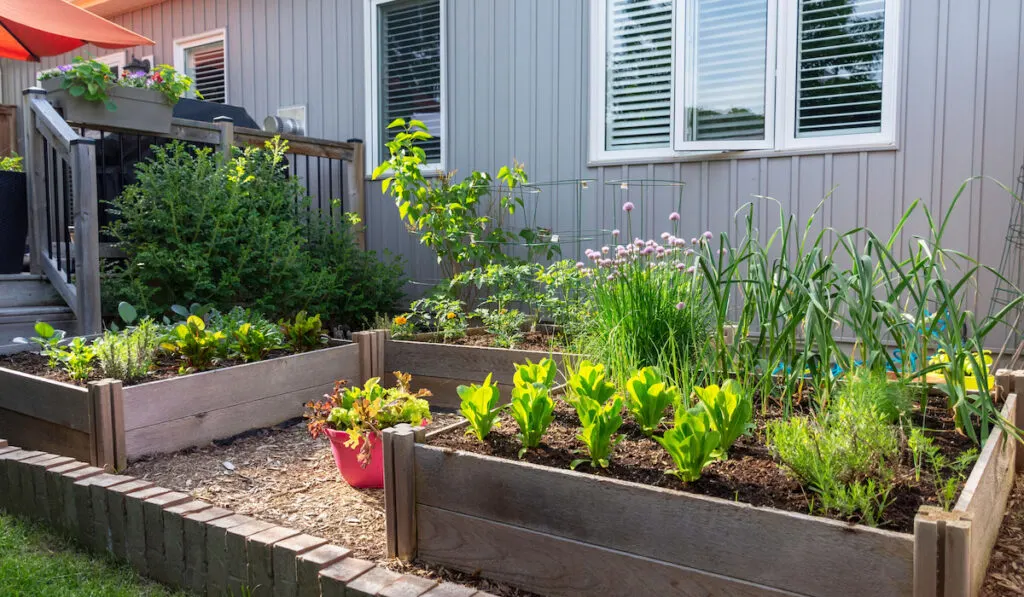
Do you think that the soil in your yard is poor and not suitable for gardening? Think again.
With proper floor lining, you can set your raised garden bed on top of any type of soil. This means that even if you live in the desert, you can grow your own crops.
Amazing, right?
3. Better for Deep-Rooted Plants
Some plants such as tomatoes grow deep roots. This means that as they grow older, their roots grow even deeper into the soil.
In raised garden beds, the roots of these plants will not get tangled easily and will keep growing, giving you healthier plants with more yield.
4. Easy to Find and Remove Weeds and Pests
Remember that raised garden beds are constructed little spaces that are highly accessible. In your raised garden bed, you can quickly find and remove weeds and pests.
With proper floor lining, you can even prevent pests from entering the raised garden bed from underneath.
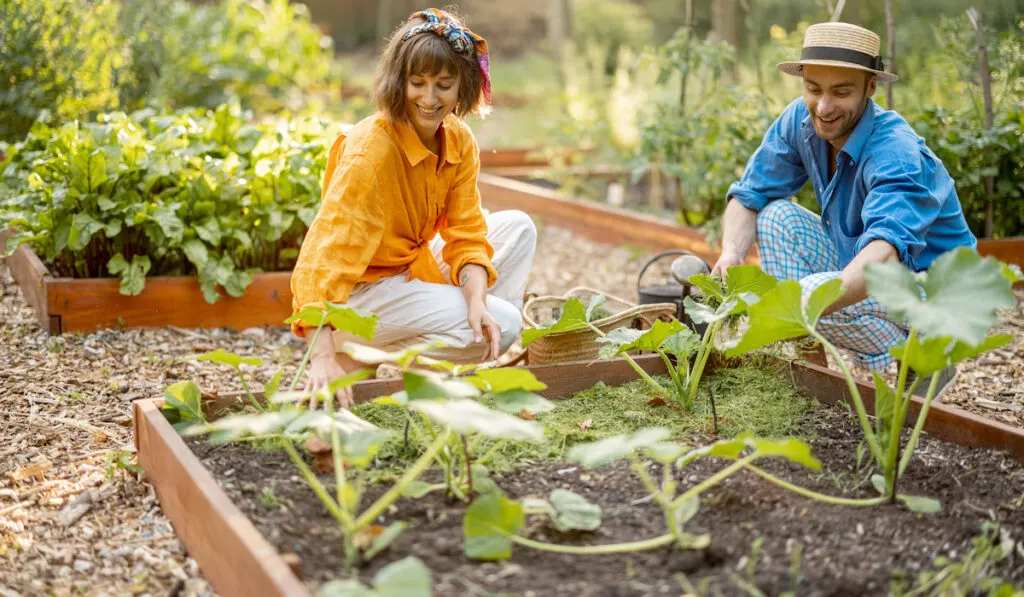
5. Best for Tubers and Other Root Vegetables
When you grow tuberous plants such as yams, potatoes, or carrots in the normal ground (without any raised bed), harvesting can be a challenge.
Natural soils settle and compact with time and rain, adhering to the roots and tubers, Digging must be done with care so that you do not ruin the harvest you have worked so hard for.
In raised garden beds, however, the soil is already higher than the ground level and is very fluffy, so it is much easier to harvest from.
With these wonderful benefits in mind, what do you need to start your own raised beds?
What Do You Need to Make a Raised Garden Bed?
Here are some items that you need to start a raised garden bed:
1. Space
It does not have to be a very large space. Just look for a place that has access to at least 6-8 hours of sunlight daily so that your sun-loving plants can grow in the raised bed.
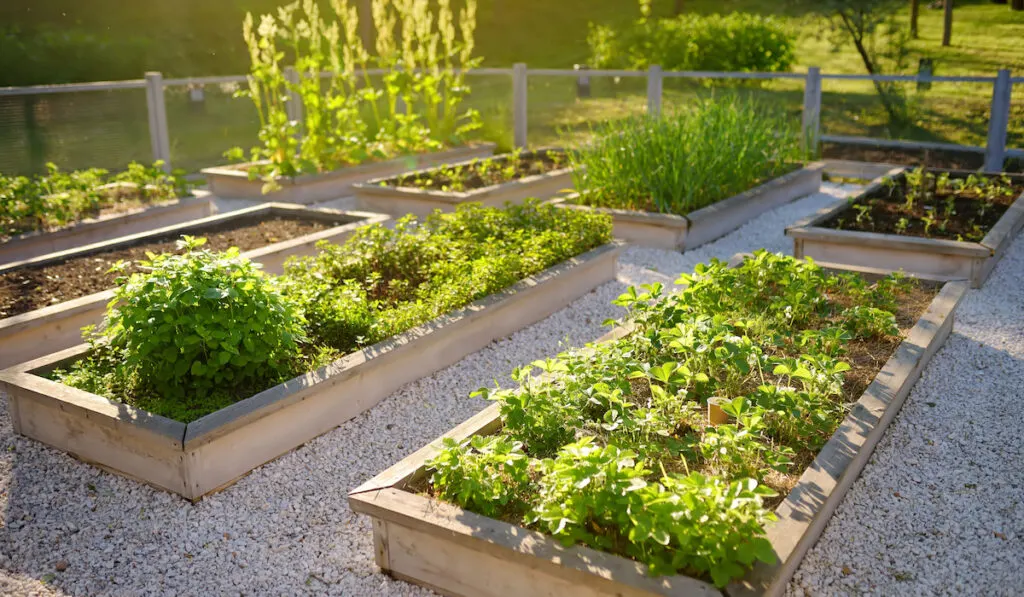
2. Soil
Soil is a major factor in gardening. You need a highly aerated soil mix for the raised garden bed. If your soil is compacted, you can mix it with sand or another soil amendment to loosen it up.
3. Frame
The raised bed frame is any material that you intend to use to give shape to your raised bed and also prevent the soil from falling away. If the frame is properly filled, it can prevent water from draining off as well.
Examples of frame materials for raised beds are:
- Wood
- Metal
- Plastics
- Concrete
- Bricks
Each material has its pros and cons, make sure you research which one meets your needs best.
4. Soil Amendments
A soil amendment is any product that you can use to improve or boost the quality of any soil at a given time.
You can amend soil to improve its pH, health, nutrients, aeration, and more. Compost, peat moss, and sand are examples of soil amendments.
5. Mulch
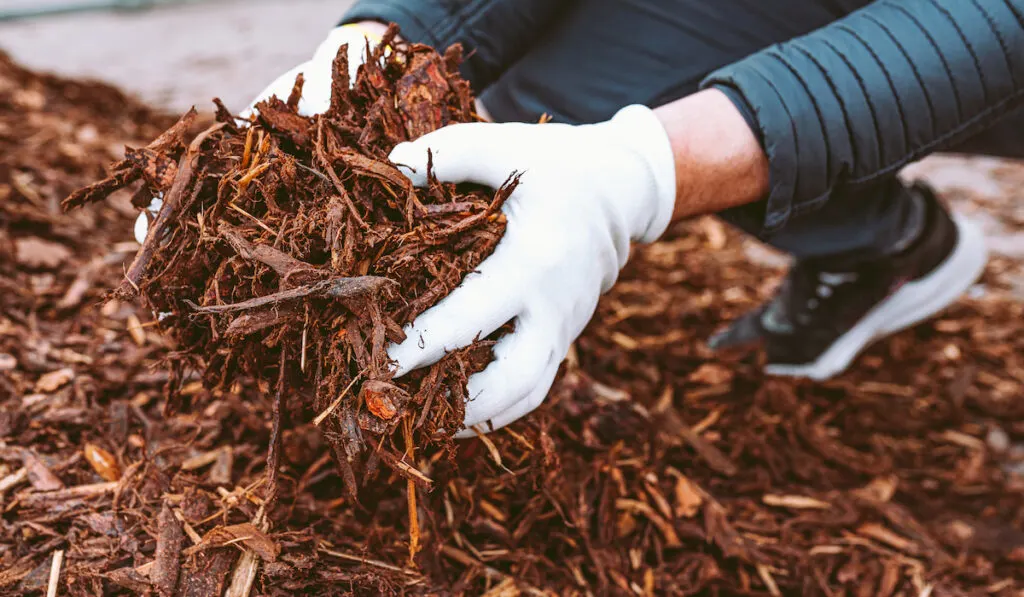
In raised bed gardening, you need mulch as much as you need soil, especially in summer. Due to the heat of the sun, water quickly evaporates from raised garden beds. Water can also drain quickly through the base of the bed.
To prevent water from evaporating, you need to mulch the entire bed with a considerable layer of mulch.
Examples of materials you can use as mulch are:
- Hay
- Straw
- Wood shavings
- Sawdust
- Sand
Each material has its pros and cons, but the best are wood shavings and sawdust.
Now you know what you need to make a raised garden bed. It is time to know when you should start.
When Should You Start Your Raised Garden Bed?
Remember that when you should start depends on the type of plants that you wish to grow. You, however, can start your raised bed at any time and then wait until the next period of cultivation before you plant your crops.
The recommended time to start a raised garden bed is just after the last frost date in your area. If you wish to use the same soil in your yard for the raised bed, you can start before winter and plant in spring.
How to Make Your Raised Garden Bed

It is time to learn how to make a raised garden bed. Follow the steps below:
- Clear the Site of Plants and Dirt: Remove every plant, dirt, or any object from the site.
- Make Sure That the Ground Is Level: If the ground is not level, some plants may suffer dehydration before others.
- Construct Your Frame: Use any material of your choice to make your frame. You can give your bed any shape you want, just make sure you can reach the center from at least one side for ease of harvesting and weeding.
- Install a Liner (Optional): If you want to use a floor liner, this is to step to install it.
- Fill with Soil: Remember that the soil should be well-aerated.
When you transplant your crops into the raised bed, you can then mulch around them.
Congratulations on constructing your raised garden bed! Now, how do you maintain the bed? Continue reading.
Using and Maintaining Your Raised Garden Beds
How do you use or maintain your raised bed to avoid any challenge? Here are some suggestions for you:
1. Water Regularly
You should know that raised garden beds can lose water quickly.
Raised garden beds quickly lose water because of evaporation and the porosity of the soil.
To prevent your plants from dehydrating quickly, you need to water your raised garden bed 2-3 times a week and 3-4 times in summer. If your deep-rooted plants are matured enough, you can reduce your watering rate.
2. Always Mulch
Mulch to prevent water from evaporating. Mulch to prevent weeds from growing. Mulch to maintain an internal soil temperature. Always mulch.
3. Check for Holes, Cracks, and Rots in the Frame
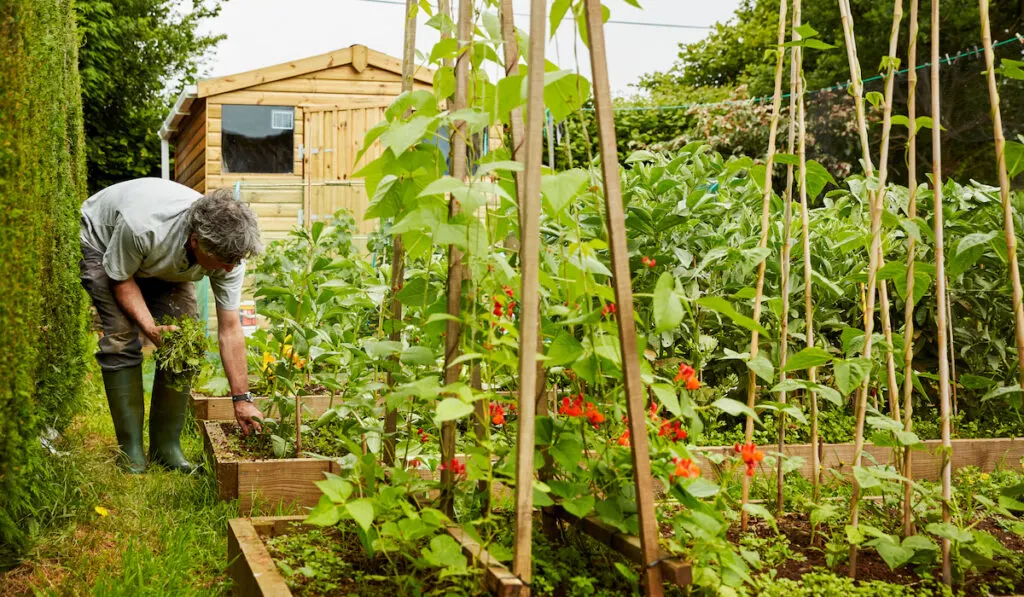
This activity is very important when maintaining raised garden beds. If your raised garden bed frame has holes, cracks, or rotten spots, it will drain off water and nutrients quickly and your plants will suffer. Rotting wood can be solved by using treated wood or another material for the frame.
If you see a hole or crack, fill it up immediately. If a part of the frame is rotting, remove that region and replace it with new material.
4. Convert Your Raised Garden Bed to a Square Foot Garden
Square foot gardening is a technique of gardening in which you will separate your raised garden bed into several partitions, each measuring 1ft square (1ft long by 1ft wide).
With square foot gardening, you can easily plan where each crop should be planted and also the right companion plant to grow between each major plant.
You will get more yield for less space with square foot gardening.
5. Use and Maintain Your Raised Garden Bed According to the Season
The way you use or maintain your raised bed depends on the time of the year. Here are good suggestions to maintain your raised garden bed according to the season.
A. Spring
Spring is a cool-season for planting. You should plant most of your crops in spring. You can even start indoors before you transplant your plants to the raised garden beds.
If your raised garden bed is new, you do not have to cultivate it. For old raised garden beds, however, you need to till and turn the soil first to aerate the soil. You also need to check for pests and weeds.
B. Summer
In summer, pay close attention to the water needs of your raised garden bed plants. You should water your plants regularly in summer.
You should also make sure that you mulch the raised garden bed to prevent water from evaporating.
C. Autumn
Pay close attention to the frame of your raised garden bed in autumn. Due to the rate of rainfall in autumn, your raised garden bed frame might start to rot if it is not treated because of fungi, bacteria, and moisture.
You should use treated wood, a liner, or another frame material to prevent your raised garden bed from rotting.
You should also water your plants less often in autumn.
D. Winter
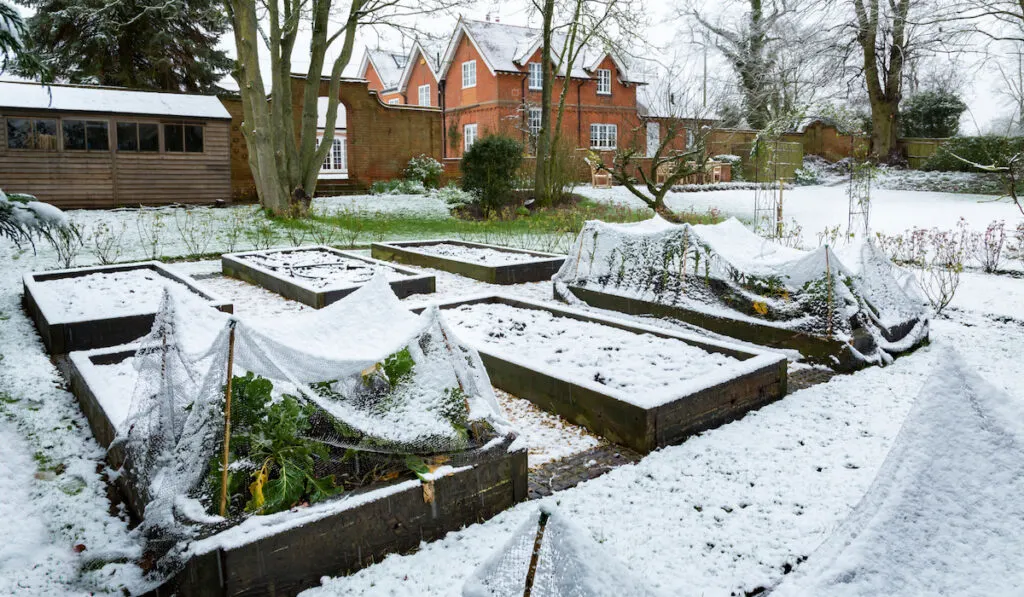
Winter is most likely the season to rest. What can you do in your raised garden bed? Here are some suggestions:
- Plant Cover Crops: Cover crops such as alfalfa, clover, etc. can prevent nutrients from leaving your raised bed. Cover crops will absorb the nutrients present and when it is spring, these crops will have decayed and released their nutrients back into the raised garden bed soil.
- Bury Fresh Manure: It is not recommended to use fresh manure in other seasons because it can burn your plants.
- In winter, however, you can mix the soil with fresh manure (or bury it into the soil) so that it can be fully decomposed and safe for plants before the next planting season.
- Cover the Raised Bed: You can use an opaque tarp to cover your raised garden bed and open it when it is time for the next planting season.
Awesome tips, right?
Related Questions and Answers
Even though you have learned a lot, you may still have a few questions.
1. How Deep Should Your Raised Garden Bed Be?
The depth of your raised garden bed depends on what you want to grow in it. For example:
- Shallow-Rooted Plants: Plants such as onions, radishes, cabbages, etc. with shallow roots need 6-12 inches of soil.
- Mid-Rooted Plants: Some tomato varieties, cucumbers, etc. need 12-24 inches of soil.
- Deep-Rooted Plants: Small shrubs, plants with woody stem, etc. need more than 24 inches of soil.
You should check the details of the plant you are purchasing or growing to know the required depth of soil.
2. Can You Plant Multiple Crops in a Raised Garden Bed?
The whole point of raised garden beds is to plant multiple species and varieties of crops in your raised garden bed. Planting more than one type of crop makes your garden beautiful and also gives you more yield when it is time to harvest.
3. What Type of Fertilizer is the Best for Raised Garden Beds?
You can use either organic or inorganic fertilizer for your raised garden bed. You can use inorganic fertilizer when you have already started your planting season. For organic fertilizer, however, it is best to use it for 2-3 weeks before you start planting.
4. How Do You Treat Wood for Raised Garden Bed Frames?
You can treat wood using linseed oil. To treat wood:
- Use sandpaper or scraper to scrape the surface of the wood so that it is fine and smooth.
- Use a hand brush or spray to apply the linseed soil on the surface of the wood.
- Allow the wood to dry under sunlight for 4-5 hours
- Reapply the linseed oil on the surface of the wood.
- After at least 3 hours, use a rag to remove excess oil off the wood surface.
- Allow it to dry.
- Plant away!
5. Are Earthworms Safe and Welcome in Raised Garden Beds?
Earthworms are your friends and are most indeed welcome in the raised garden bed. Some benefits of earthworms are:
- Soil Aeration: When earthworms move, they help aerate the soil, giving more oxygen to the roots of your plants.
- Decomposition. Earthworms are not actual decomposers, but they help fungi and bacteria to consume organic matter and excrete castings that fungi and bacteria can easily decompose.
- Plant Health: Earthworms help consume the dead or dying parts of plants, helping plants to send nutrients to healthy parts.
You should allow and encourage earthworms to live in your raised garden bed.
Final Thoughts
Raised garden beds have so many benefits. Use the procedures in this article to make your raised bed and garden in it successfully.
Don’t forget to maintain your raised bed and also water your crops regularly.
Sources
- https://joegardener.com/podcast/raised-bed-gardening-pt-1/
- https://www.almanac.com/content/how-build-raised-garden-bed
- https://learn.eartheasy.com/articles/how-to-build-a-raised-garden-bed-best-kits-and-diy-plans/
- https://www.gardenersworld.com/how-to/diy/how-to-build-a-raised-bed/
- https://www.creativevegetablegardener.com/easy-raised-garden-bed/
